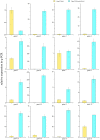Comparative Transcriptome Reveals Benzenoid Biosynthesis Regulation as Inducer of Floral Scent in the Woody Plant Prunus mume
- PMID: 28344586
- PMCID: PMC5345196
- DOI: 10.3389/fpls.2017.00319
Comparative Transcriptome Reveals Benzenoid Biosynthesis Regulation as Inducer of Floral Scent in the Woody Plant Prunus mume
Abstract
Mei (Prunus mume) is a peculiar woody ornamental plant famous for its inviting fragrance in winter. However, in this valuable plant, the mechanism behind floral volatile development remains poorly defined. Therefore, to explore the floral scent formation, a comparative transcriptome was conducted in order to identify the global transcripts specifying flower buds and blooming flowers of P. mume. Differentially expressed genes were identified between the two different stages showing great discrepancy in floral volatile production. Moreover, according to the expression specificity among the organs (stem, root, fruit, leaf), we summarized one gene cluster regulating the benzenoid floral scent. Significant gene changes were observed in accordance with the formation of benzenoid, thus pointing the pivotal roles of genes as well as cytochrome-P450s and short chain dehydrogenases in the benzenoid biosynthetic process. Further, transcription factors like EMISSION OF BENZENOID I and ODORANT I performed the same expression pattern suggesting key roles in the management of the downstream genes. Taken together, these data provide potential novel anchors for the benzenoid pathway, and the insight for the floral scent induction and regulation mechanism in woody plants.
Keywords: Mei; benzenoid biosynthesis; floral scent; transcription factors; transcriptome.
Figures










Similar articles
-
Comparative transcriptome analysis linked to key volatiles reveals molecular mechanisms of aroma compound biosynthesis in Prunus mume.BMC Plant Biol. 2022 Aug 9;22(1):395. doi: 10.1186/s12870-022-03779-3. BMC Plant Biol. 2022. PMID: 35945501 Free PMC article.
-
Integration of Transcriptome and Methylome Analyses Provides Insight Into the Pathway of Floral Scent Biosynthesis in Prunus mume.Front Genet. 2021 Dec 15;12:779557. doi: 10.3389/fgene.2021.779557. eCollection 2021. Front Genet. 2021. PMID: 34976015 Free PMC article.
-
Transcriptome profiling provides new insights into the formation of floral scent in Hedychium coronarium.BMC Genomics. 2015 Jun 19;16(1):470. doi: 10.1186/s12864-015-1653-7. BMC Genomics. 2015. PMID: 26084652 Free PMC article.
-
Regulation of volatile benzenoid biosynthesis in petunia flowers.Trends Plant Sci. 2006 Jan;11(1):20-5. doi: 10.1016/j.tplants.2005.09.009. Epub 2005 Oct 12. Trends Plant Sci. 2006. PMID: 16226052 Review.
-
Circadian Rhythms in Floral Scent Emission.Front Plant Sci. 2016 Apr 13;7:462. doi: 10.3389/fpls.2016.00462. eCollection 2016. Front Plant Sci. 2016. PMID: 27148293 Free PMC article. Review.
Cited by
-
Comprehensive Analysis of Endogenous Volatile Compounds, Transcriptome, and Enzyme Activity Reveals PmCAD1 Involved in Cinnamyl Alcohol Synthesis in Prunus mume.Front Plant Sci. 2022 Feb 18;13:820742. doi: 10.3389/fpls.2022.820742. eCollection 2022. Front Plant Sci. 2022. PMID: 35251090 Free PMC article.
-
Integrative metabolome and transcriptome analyses reveal the molecular mechanism underlying variation in floral scent during flower development of Chrysanthemum indicum var. aromaticum.Front Plant Sci. 2022 Sep 15;13:919151. doi: 10.3389/fpls.2022.919151. eCollection 2022. Front Plant Sci. 2022. PMID: 36733600 Free PMC article.
-
Volatile Composition and Classification of Paeonia lactiflora Flower Aroma Types and Identification of the Fragrance-Related Genes.Int J Mol Sci. 2023 May 28;24(11):9410. doi: 10.3390/ijms24119410. Int J Mol Sci. 2023. PMID: 37298360 Free PMC article.
-
Histochemical and molecular analyses reveal an insight into the scent volatiles synthesis and emission in ephemeral flowers of Murraya paniculata (L.) Jack.Planta. 2024 Oct 18;260(5):119. doi: 10.1007/s00425-024-04552-6. Planta. 2024. PMID: 39422757
-
Metabolic, Enzymatic Activity, and Transcriptomic Analysis Reveals the Mechanism Underlying the Lack of Characteristic Floral Scent in Apricot Mei Varieties.Front Plant Sci. 2020 Oct 22;11:574982. doi: 10.3389/fpls.2020.574982. eCollection 2020. Front Plant Sci. 2020. PMID: 33193512 Free PMC article.
References
-
- Audic S., Claverie J. M. (1997). The significance of digital gene expression profiles. Genome Res. 7, 986–995. - PubMed
-
- Chandran A. K., Lee G. S., Yoo Y. H., Yoon U. H., Ahn B. O., Yun D. W., et al. . (2016). Functional classification of rice flanking sequence tagged genes using MapMan terms and global understanding on metabolic and regulatory pathways affected by dxr mutant having defects in light response. Rice (N Y). 9, 17. 10.1186/s12284-016-0089-2 - DOI - PMC - PubMed
LinkOut - more resources
Full Text Sources
Other Literature Sources
Research Materials

